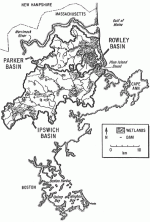In 1992, Plum Island Sound in the Acadian biogeographic province, was added to the LMER Network. This brings the total number of LMER investigations to five with studies now focused in three different biogeographic provinces, two in the Oregonian Province, two in the Virginian and one in the Acadian. The Plum Island Sound Comparative Estuarine Study (PISCES) is being led by C. Hopkinson and includes L. Deegan, A. Giblin, J. Hobbie (Marine Biological Laboratory), J. Finn (University of Massachusetts) and R. Buchsbaum (Massachusetts Audubon Society).
The Plum Island Sound System (630 1cm2) has a relatively small, bar-built estuary. Three formerly glaciated upland watersheds (585 km) drain into the estuary and have markedly different land covers, from the Parker River watershed (155 km2), a largely undisturbed drainage basin with extensive upland, bottomland hardwood and cedar swamp forests, to the larger (404 km2) and much more “developed” Ipswich River watershed. “Bedroom” communities of the Boston metropolitan region occupy the southwestern, upstream portion of the Ipswich watershed. Expansive river wetlands extensively process nutrient- and sediment-laden upland runoff before it enters tidal portions of the estuary. The well-mixed estuary has a tidal BOSTON prism (2.6 m tide) that transports 65 times more water on a daily basis than mean freshwater input from the watershed. The Plum Island Sound system contains the greatest expanse of tidal wetlands in New England.
PISCES is focused primarily on the effects of organic matter inputs. Research investigates two broad questions:
- What is the importance to estuarine ecosystems of organic carbon and organic nitrogen inputs from watersheds with various land covers and uses?
- Does the interaction of inorganic nutrients with the quantity and quality of organic carbon and organic nitrogen play an important role in determining the trophic structure, production, and trophic efficiency in estuaries? In systems dominated by inorganic nutrient inputs, our preliminary models indicate we can expect short and efficient foodwebs beginning with large phytoplankton species.
In contrast, our models suggest that systems dominated by low-quality organic matter inputs will be characterized by long, inefficient foodwebs beginning with bacteria, with an active microbial loop community and with intense competition for nutrients between bacteria and primary producers.
PISCES applies a combination of experimental, comparative ecosystem, and descriptive studies to evaluate specific hypotheses within the two broad research questions. To help us reach conclusions and construct models that are generally applicable across a wide range of coastal systems, experimental and descriptive findings from Plum Island Sound will be “validated” by conducting comparative studies at different coastal LTER and LMER sites that represent end-members in our analysis of interactions between organic matter and inorganic nutrient loading. There are four components to the effort:
- Quantification of organic carbon and nutrient exports from watersheds with different land use
- Descriptive measurements of organic matter fluxes and experimental determination of controls of processes in the Plum Island Sound estuary
- Comparative ecosystem experiments at other LTER or LMER sites to assess the generality of results obtained in Plum Island Sound
- Modeling to predict the effects of land use and climate changes on estuarine trophic structure and function

 Enlarge this image
Enlarge this image